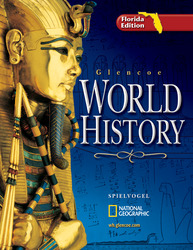Glencoe World History, Florida EditionChapter 21:
The Height of Imperialism, 1800–1914Chapter OverviewsThe search for sources of raw materials and markets for industrial products spurred the European powers and the United States to colonize large areas of Asia, Africa, and Latin America. Some advocates of imperialism had humanitarian intentions, but resentment of abuses and rising nationalism led native populations to demand independence. Section 1 Colonial Rule in Southeast Asia
The nineteenth century saw the emergence of a new imperialism in Asia and Africa. By establishing overseas colonies, Western powers saw an opportunity to improve their access to both raw materials and new markets for their manufactured goods. Racism, Social Darwinism, and humanitarian and religious goals all helped Westerners justify colonization. Virtually all of Southeast Asia came under the control of Great Britain, France, and the United States. Only Thailand stayed independent. Colonial powers ruled either indirectly, relying mainly on local elites, or directly by sending a governor. While some local people profited from the colonial arrangement, most suffered from the harsh conditions of plantation work. Resistance movements sought to protect local economic and religious interests but were crushed by the colonial powers. Later, Western-educated elites led resistance movements with a new goal—national independence. Section 2 Empire Building in Africa
European control over Africa began with British annexations in West Africa. After 1880, great power rivalries prompted France, Germany, Portugal, Belgium, and Italy to begin seeking territory in Africa. In Egypt, an Ottoman army officer named Muhammad Ali set up an independent state and began modernizing the country. Great Britain's interest in the Suez Canal led to the establishment of a British protectorate. Belgium and France staked claims to lands around the Congo River in central Africa, while Germany, despite the reluctance of Bismarck, claimed territories in West and East Africa. British involvement in southern Africa led to the Boer War against the descendants of seventeenth-century Dutch settlers and the establishment of the Union of South Africa. Resentment of the colonial powers led to the emergence of nationalist movements, especially as a new class of educated middle-class Africans began to point to the hypocrisy and discriminatory nature of colonial rule. Section 3 British Rule in India
The British controlled India at first through the British East India Company, which had its own forts and soldiers. A revolt led by Indian soldiers prompted the British to appoint a British viceroy to rule the country. The British developed India economically—building railroads and creating an education system for the upper class. Yet Indians paid a high price for British rule. British manufactured goods destroyed local industries. The abuses of tax collectors and the superior British attitude and lifestyle caused many Indians to resent the British. The Indian National Congress led calls for reform. A Muslim League formed to represent Muslim concerns. The most prominent anti-British movement was led by Mohandas Ghandi, a Western-educated lawyer who advocated non-violent resistance as a way to gain independence. Tense relations with the British led to an Indian cultural revival. Section 4 Nation Building in Latin America
After the Napoleonic Wars, Spanish and Portuguese authority in Latin America became weak. A slave revolt in Hispaniola was the first of many successful bids for independence. Many Europeans favored the restoration of Spanish control, but the American Monroe Doctrine and British naval power discouraged European intervention. Caudillos, or strong leaders backed by military force, took power throughout Latin America. American settlers in the Mexican state of Texas gained independence and, later, American statehood. Great Britain, and later the United States, became the dominant foreign power. In the Spanish-American War, the United States gained control of Cuba and Puerto Rico. American investment and military intervention in Latin America grew. Revolution in Mexico produced a new reformist constitution. However, the new professional sector in Latin American society was generally conservative and allied itself with landholding elites.  | 

















